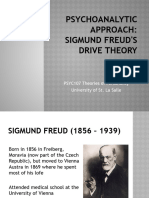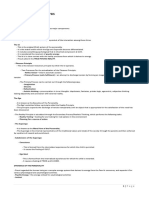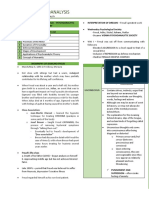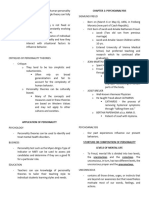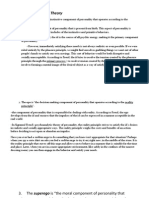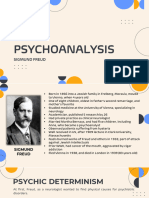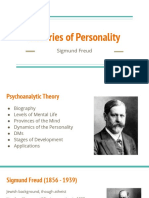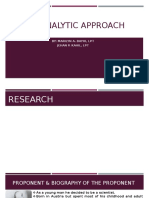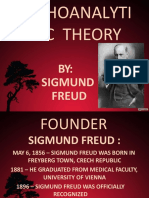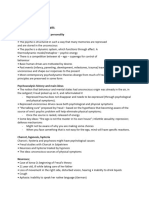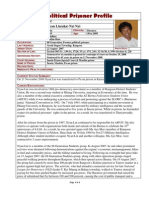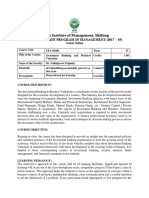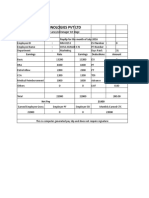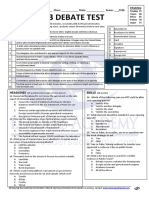19/02/2023
PSYCHOANALYTIC THEORY Sigmund Freud
OVERVIEW
Personality is largely unconscious, hidden, and unknown.
Concept of sexual energy helps us gratify and survive, not always
genitals (ex. Eating)
Human personality and behavior are powerfully shaped by early
childhood relationships
People are hedonistic (pleasure seeking)
Aim of psychoanalysis is to reduce tension
1
� 19/02/2023
DYNAMICS OF PERSONALITY
Freud postulated a DYNAMIC, or MOTIVATIONAL PRINCIPLE, to
explain the driving forces behind people’s actions.
To Freud, people are motivated to seek pleasure and to reduce
tension and anxiety (Tension – unpleasant feeling)
INSTINCT - drive or impulse mental representations of internal
stimuli, that drive a person to take certain actions (Ex: Hunger)
REPETITION COMPULSION: aspect of an instinct which reflects a
cycle from excitation to quiescence. This cycle repeats every time
one experiences tension or excitation.
LEVELS OF THE MIND
1. Conscious: top and small portion
2. Pre-Conscious: contains defense
mechanisms and memory
3. Unconscious: animalistic-causing drives
Phylogenetic Endowment: part of our
unconscious that originates experiences of our
early ancestors that have been passed on to
us through hundreds of generations of
repetition
2
� 19/02/2023
PROVINCES OF THE MIND
ID
•Upon birth, the Id is the only personality structure
•Core of the personality
•Buried in the Unconscious
•Strives constantly to reduce tension by satisfying basic desires;
actions are governed by the “pleasure principle” (e.g., sucking
nipple/thumb/toy, defecating/urinating)
•“the Id is primitive, chaotic, inaccessible to consciousness,
unchangeable, amoral, illogical, unorganized, and filled with
energy received from basic drives and discharged for
satisfaction”
PROVINCES OF THE MIND
EGO
•Starts to develop around 2nd year in life
•Mind’s source of communication with external world; operates according
to the “reality principle”
•Decision-maker - The Ego satisfies the Id or the Superego to reduce
“tension”, but takes into account the realities of the world (conscious),
past experiences (preconscious), and desires (unconscious)
•Many times it uses defense mechanisms to defend itself from anxiety
that results from the hostile Id, Superego and Reality
•Healthy Mind/Maturity – is having a strong Ego that does not
allow the Id or Superego to have too much control over the
personality.
3
� 19/02/2023
PROVINCES OF THE MIND
SUPER EGO
•Develops around the 5th year of life
•Represents the standards, ideals and values of the of the society and the “elders” in
particular; operates in the “moralistic or idealistic principle”, but has no contact with the
real world
•Promotes behaviors worthy of praise, which can increase our self-esteem, opposes the Id
and the Ego, and uses guilt to restrain
•Two sub-systems of the Superego:
1. The Conscience – forms out the experiences with punishments; prescribes what “should not
be done”
2. The Ego-ideal – forms out of the experiences with rewards; prescribes what “should be
done”
DRIVE
Psychological or mental representation of an inner bodily
source of excitement
Cathexis or Object-cathexis: investment of libidinal energy
to fulfill a need
Anti-cathexis: When the id becomes too impulsive and
threatening, the ego erects it
Identification: action of finding the right object to
counterpart the image
Psychic energy is displaceable for variations in object-
choice
4
� 19/02/2023
FOUR FEATURES OF DRIVES
SOURCE: stimulus or need, something in deficit
IMPETUS: amount of energy or intensity
AIM: goal or purpose
OBJECT: object or person that will satisfy
BASIC GROUPS OF DRIVES
👠
SEX /EROS: for survival, productivity, life, satisfying 🍆🍔
physiological need
Libido - energy force of Eros; form of psychic energy,
manifested by the life instincts, that drives a person toward
pleasurable behaviors and thoughts
Erogenous Zones: Organs of the body that are especially
sensitive to the reception of pleasure.
In Freudian theory, the three principal erogenous zones are
the mouth. anus and genitals.
5
� 19/02/2023
BASIC GROUPS OF DRIVES
AGGRESSIVE DRIVE / THANATOS: the compulsion to
destroy, conquer, and kill, goal is to regress or to go back to
inorganic state
Self- Destruction - the final aim of aggressive drive
Positive side is to realize that time is limited which make
humans move away from Thanatos.
The aggressive tendency is present in everyone and is the
explanation for wars, violence, and religious persecution
Ex: teasing, gossip, sarcasm, humiliation, humor, and the
enjoyment of other people's suffering
TYPES OF INSTINCTS
LIFE INSTINCTS: the drive for ensuring survival of the individual
and the species by satisfying the needs for food, water, air, and
sex
DEATH INSTINCTS: the unconscious drive toward decay,
destruction, and aggression; guided by constancy principle
Constancy principle
Freud calls this the nirvana principle
The principle of constancy is the principle of psychic functioning
that seeks to maintain the quantity of excitation contained in the
vessel at a low or constant level
6
� 19/02/2023
TYPES OF ANXIETY
NEUROTIC ANXIETY - Caused by id impulses that the ego can barely
control, apprehension about an unknown danger
- People may experience neurotic anxiety in the presence of a teacher,
employer, or some other authority figure because they previously experienced
unconscious feelings of destruction against one or both parents
MORAL ANXIETY - Comes from threats of punishment
from the superego, children establish a superego usually
by the age 5 or 6
REALISTIC ANXIETY - this kind of anxiety is defined as
an unpleasant, nonspecific feeling involving a possible
danger. It is closely related to fear.
7
� 19/02/2023
DEFENSE MECHANISMS
REPRESSION - Blocking a wish or desire from conscious expression, can uncover through
hypnosis, cornerstone of all defense mechanisms
DENIAL - Refusal to accept unpleasant reality
PROJECTION - Externalizing or attributing an unconscious impulse to another person
INTROJECTION - People incorporate positive qualities of another person into their ego
REACTION FORMATION - Doing things that is opposite with what you feel
REGRESSION - Returning to an earlier stage through expressing an impulse
SUBLIMATION - Doing things that are socially acceptable, positive and productive,
highest form or most mature defense mechanism
DEFENSE MECHANISMS
DISPLACEMENT - Displacing emotions to inanimate objects or subordinates
RATIONALIZATION - Behaviors or feelings are justified and explained in a
seemingly rational or logical manner to avoid the true explanation
- Sweet lemoning (pretending to like what one really dislikes) or sour graping
(pretending to dislike what one really likes)
INTELLECTUALIZATION - Focuses on the cognitive aspect and attempts to isolate the
emotion involved
IDENTIFICATION - Modeling someone's behavior after the behavior of someone else
UNDOING - "cancel out" or "make-up" for a bad act by doing good
COMPENSATION - people overachieve in one area to compensate for failures in
another
8
� 19/02/2023
GOAL OF PSYCHOANALYSIS
(1)To strengthen our censors, (2)To uncover repressed memories
TRANSFERENCE: Strong, undeserved feelings that the patient develops toward the
analyst during the course of treatment. These feelings may be either sexual or hostile but
they stem from the patient's earlier experiences with parents.
COUNTERTRANSFERENCE: Strong, undeserved feelings that the therapist develops
toward the patient during the course of treatment. These feelings can be either positive
or negative.
CATHARSIS: the process of reducing or eliminating a complex by recalling it to conscious
awareness and allowing it to be expressed
FREE ASSOCIATION: Fundamental rule of psychoanalysis technique in which the therapist
encourages patients to report, without restriction, any thoughts that occur to them
DREAM ANALYSIS
Procedure used to probe the unconscious through
interpretation of the patient's dreams
They are a type of wish fulfilment, that is, a
representation of what the individual would like to have
Contents of Dream
Manifest Content: what the dreamer sees and remembers
Latent Content: the meaning of the manifest content, what
is the unconscious interpretation of the said dream.
9
� 19/02/2023
PARAPRAXES OR FREUDIAN SLIPS
Slips of the tongue or pen, misreading,
incorrect hearing misplacing objects, and
temporarily forgetting names or
intentions that are not chance accidents
but reveal a person's unconscious
intentions
Ex: A husband might refer to his wife by
her maiden name may unconsciously wish
he'd never married this woman.
SYMBOLISMS
HUMOR
According to Freud for a joke to be funny, it must contain
anxiety provoking material.
We laugh only at the things that bother us. Most often, sex
and death are favorite topics
According to Freud, if you want to know what's in a person's
mind, examine what he or she finds humorous.
SYMBOLIC BEHAVIOR
Our unconscious desires are interpreted as symbolic
representations thus many of our daily behaviors be taken as
symbols or gestures of these unconscious thoughts
10
� 19/02/2023
END.
11








